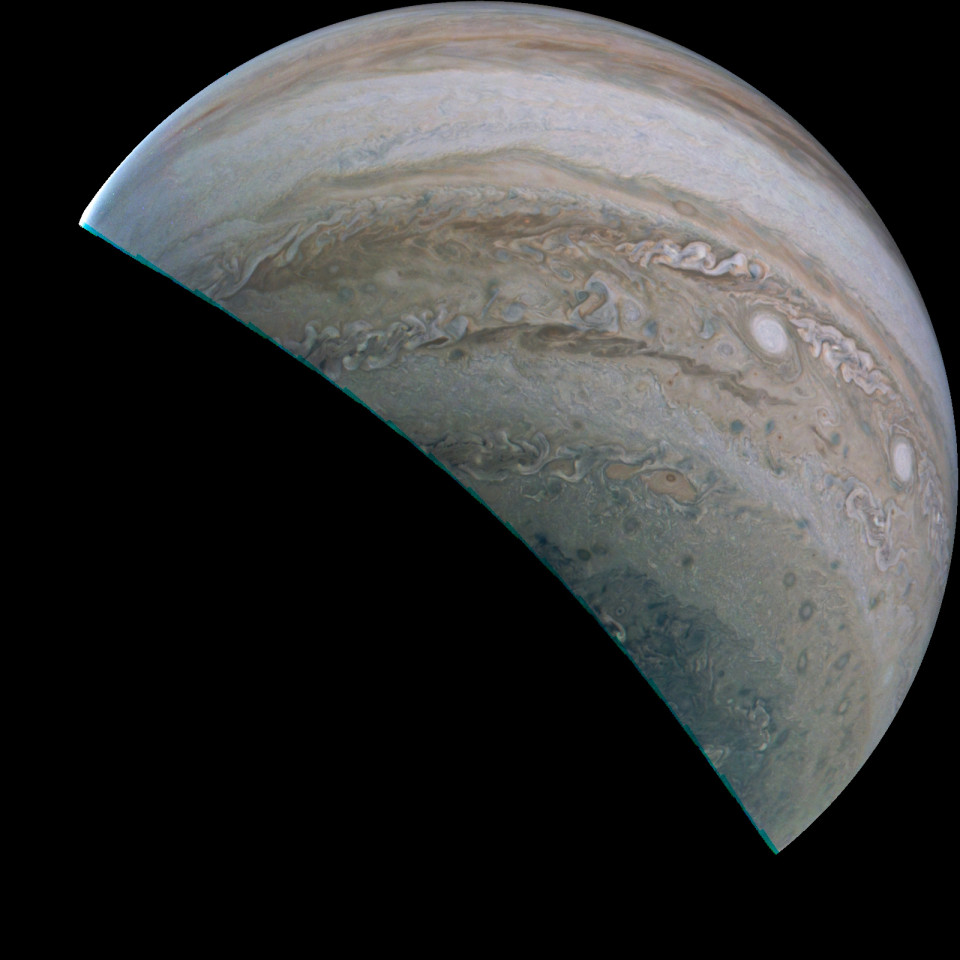NASA Juno spacecraft will soon fly close to a trio of moons, one of which is considered to have suitable life conditions
Recently, NASA released a picture showing a partial view of Jupiter that highlights the gas giant’s wild and swirly atmosphere. “Using data from Juno’s instruments, scientists discovered that Jupiter’s powerful atmospheric jet streams extend far deeper than previously imagined. Evidence from Juno shows the jet streams and belts penetrate about 1,800 miles (3,000 kilometers) down into the planet”, states NASA.

Credits:NASA
But this recent breakthrough seems that’s only the prologue in a series. In a recent statement, NASA released the information that Juno mission will expand into the future. The spacecraft, which has been gathering data on the gas giant since July 2016, will become an explorer of the full Jovian system.
“Since its first orbit in 2016, Juno has delivered one revelation after another about the inner workings of this massive gas giant,” said principal investigator Scott Bolton of the Southwest Research Institute in San Antonio. “With the extended mission, we will answer fundamental questions that arose during Juno’s prime mission while reaching beyond the planet to explore Jupiter’s ring system and Galilean satellites.”
Even though Jupiter’s atmosphere is a brutal environment, Juno is sheathed in titanium armor that protects it from harsh radiation. “I’m really excited, just thrilled that we were able to come up with this plan,” Bolton stated.
Which moons will be inspected?
According to National Geographic, as Juno continues its surveillance of the system, its loops around Jupiter will tighten, bringing the spacecraft closer and closer to our solar system’s largest planet and within range of three of Jupiter’s most intriguing moons.
Jupiter’s enigmatic Great Blue Spot, an isolated patch of intense magnetic field near the planet’s equator, will be the target of a high-spatial-resolution magnetic survey during six flybys early in the extended mission. As Juno’s orbit evolves, there are planned multiple flybys of the moons Ganymede, Europa, and Io, as well as multiple passages through Jupiter’s tenuous rings.
Ganymede is the largest moon in the solar system. The plan is that in this June images of its surface will be recorded by Juno. Next, in 2022, it will visit Europa which is an ice-encrusted ocean world that could harbor life. Finally, Juno will encounter Io, a violentely volcanic moon dusted with sulfuric frost.
“It’s so rare to get a mission to the outer solar system, and it’s just amazing that we can take advantage of this spacecraft that’s there,” says Cynthia Phillips of the Jet Propulsion Laboratory, who studies the outer solar system’s icy moons. “It’s basically a whole new mission.”
Are there any moons suitable for life?
It seems that the best chances to find alien life and a suitable replacement for Earth are with Europa moon. That is due to the fact that a deep, global ocean lies beneath the moon’s frozen, criss-crossed crust. This ocean might be as much as 100 kilometers deep. In fact, Europa’s ocean is so vast that it contains between two and three times as much water as the one in Earth’s oceans combined.
Scientists suspect that this ocean contains all the ingredients necessary for life: water, an energy source, and essential chemical elements. As mentioned above, next year, Juno will fly by Europa three times. As it does, it will look for any signs of water vapors or geysers. This phenomena occur sporadically on Europa’s surface.
Juno will also scan the ice shell for pockets of liquid water. As it scans the surface, Juno will make a map of Europa’s never-before-seen poles. “By imaging these unseen parts of Europa, we can tie together a global map,” Phillips states. “It’s not like with Mars, where we’ve sent a zillion mission.”

Credit: NASA/JPL-Caltech/SETI Institute




